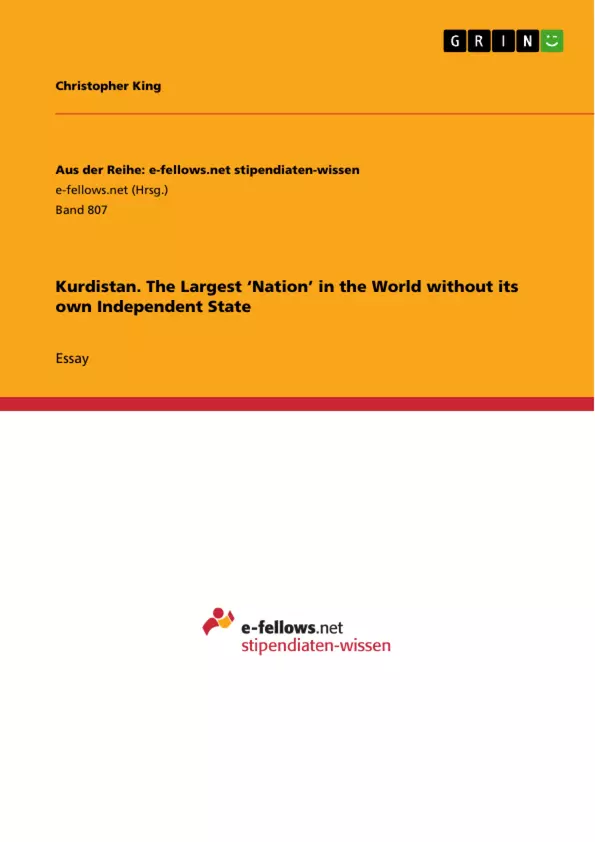In a continually globalizing world, the question of identity becomes more and more prevalent among societies. What is identity? How do we define it? Across the world individuals are seeking to belong to something that can define them and give them something to set them apart from the other seven billion people in residency on the planet. However, also as these questions become increasingly important, conflicts can arise between different ethnic, cultural, or societal groups. Presently, one of the more notable examples of this is that of the Kurds and their continued struggle for a state of their own. The Kurds make up “the largest nation in the world without its own independent state” (Gunter 2004: 197). Spread across Iraq, Iran, Turkey, Syria, and even small parts of Armenia (cf. Yavuz 1998: 9), the Kurds are a scattered people across various state borders. With this in mind, can one speak legitimately of a Kurdish ‘nation’ and if so would creating an independent Kurdish state truly benefit the Kurdish people?
Table of Contents
- 1. Introduction
- 2. History of the Conflict
- 3. Analysis of the Conflict
- 4. Conclusion and Policy Recommendations
Objectives and Key Themes
This paper examines the Kurdish struggle for statehood, analyzing the historical context, the complexities of Kurdish identity, and the obstacles to achieving an independent Kurdistan. It aims to provide a nuanced understanding of the challenges and potential solutions related to the Kurdish question.
- The historical context of the Kurdish struggle for self-determination.
- The multifaceted nature of Kurdish identity and the internal divisions within the Kurdish population.
- The geopolitical obstacles to Kurdish independence, including the positions of neighboring states.
- The role of shared oppression and a shared narrative in shaping Kurdish identity.
- Potential policy recommendations for addressing the Kurdish question.
Chapter Summaries
1. Introduction: This introductory chapter establishes the central question of the paper: Can the Kurds, the world's largest nation without a state, legitimately claim nationhood, and would an independent Kurdish state benefit them? It introduces the concept of identity in a globalizing world and highlights the Kurds' dispersed population across several countries, setting the stage for the subsequent analysis of their complex situation.
2. History of the Conflict: This chapter traces the historical roots of the Kurdish conflict back to the collapse of the Ottoman Empire and the subsequent imposition of nation-state boundaries that divided the Kurdish population. The chapter emphasizes how the partitioning, driven by the ideology of the nation-state, left the Kurds as a marginalized minority scattered across Syria, Iraq, Iran, and Turkey, fostering a sense of shared oppression and contributing to the rise of Kurdish nationalism.
3. Analysis of the Conflict: This chapter delves into the complexities of Kurdish identity, highlighting its diverse linguistic, historical, and geographical components. It explores the role of shared suffering and the struggle for independence in forging a collective Kurdish identity, referencing relevant theories of nationalism and ethnicity. The chapter also examines the internal divisions within the Kurdish population, highlighting how differing experiences of oppression have shaped unique identities across different regions, creating obstacles to achieving a unified nation-state. The chapter also discusses the lack of international support for Kurdish independence, further complicating the situation.
Keywords
Kurdish nationalism, Kurdish identity, nation-state, ethnic nationalism, Kurdistan, Ottoman Empire, shared oppression, geopolitics, self-determination, policy recommendations, internal divisions, imagined community.
Frequently Asked Questions: A Comprehensive Language Preview
What is the main topic of this document?
This document is a comprehensive language preview providing an overview of a paper examining the Kurdish struggle for statehood. It analyzes the historical context, the complexities of Kurdish identity, and the obstacles to achieving an independent Kurdistan.
What does the Table of Contents include?
The Table of Contents includes an introduction, a section on the history of the conflict, an analysis of the conflict, and a conclusion with policy recommendations.
What are the main objectives and key themes explored in the paper?
The paper aims to provide a nuanced understanding of the challenges and potential solutions related to the Kurdish question. Key themes include the historical context of the Kurdish struggle for self-determination, the multifaceted nature of Kurdish identity and internal divisions, geopolitical obstacles to independence, the role of shared oppression in shaping Kurdish identity, and potential policy recommendations.
What are the key takeaways from each chapter?
Chapter 1 (Introduction): Introduces the central question of whether Kurds can legitimately claim nationhood and the benefits of an independent Kurdish state. It establishes the context of Kurdish identity in a globalizing world and their dispersed population.
Chapter 2 (History of the Conflict): Traces the historical roots of the Kurdish conflict to the collapse of the Ottoman Empire and the subsequent division of the Kurdish population. It emphasizes how this partitioning marginalized Kurds and contributed to the rise of Kurdish nationalism.
Chapter 3 (Analysis of the Conflict): Delves into the complexities of Kurdish identity, highlighting its diverse components and the role of shared suffering in forging a collective identity. It also examines internal divisions within the Kurdish population and the lack of international support for independence.
What are the keywords associated with this paper?
Keywords include Kurdish nationalism, Kurdish identity, nation-state, ethnic nationalism, Kurdistan, Ottoman Empire, shared oppression, geopolitics, self-determination, policy recommendations, internal divisions, and imagined community.
- Citation du texte
- Christopher King (Auteur), 2013, Kurdistan. The Largest ‘Nation’ in the World without its own Independent State, Munich, GRIN Verlag, https://www.grin.com/document/262777



